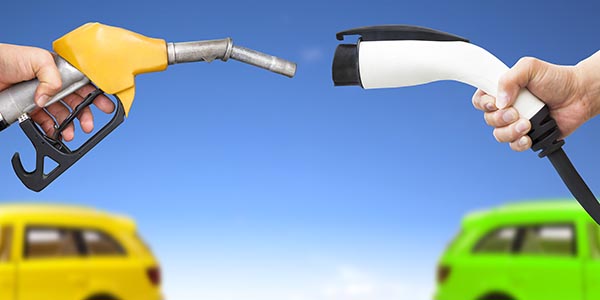
 |
Dr Christian Calvillo Research Associate, Centre for Energy Policy christian.calvillo@strath.ac.uk |
 |
Dr Gioele Figus Research Associate, Centre for Energy Policy gioele.figus@strath.ac.uk |
 |
Dr Antonios Katris 23 November 2017 |
When the Scottish Government announced the intention to phase out the need for petrol and diesel cars by 2032, 8 years before the ban announced by the UK Government, it was to be expected that this surprising announcement would eventually be at the centre of an interesting debate.
The Centre for Energy policy took this opportunity to organise a conversation where members of the community, including students, academics, civil servants and citizens could exchange ideas and express their views.
Discussions around the future are fascinating, especially when it comes to imagine how technology will change our lives. In the past century, science fiction movies have often imagined dystopian societies where cars can fly and go incredibly fast.
Today, our Governments try to use their imagination to plan a future where cars (with wheels) are powered by low emission energy sources. However, to some people this still seems a utopic vision, especially given the limited timeframe.
Charging points and network capacity
Switching from petrol and diesel to electric cars will have undoubtedly benefits on the quality of the air, especially in urban areas. However, there are concerns regarding the capacity of the network to cope with the increased electricity demand, as well as the need for charging points and whether these can be made widely available and easily accessible to every owner of electric vehicles.
Some of the conversationalists tried to use figures to express confidence that the necessary electricity to powere electric cars could be generated from renewables. It has been remarked that the extra electric load to charge EVs will require around 4 GW of new capacity, but in the grand scheme of things, this does not seem to be a particularly ambitious challenge.
One of the main downsides of certain renewables sources, such as wind, is the uneven generation of electricity, which does not necessarily match the demand. A view that was brought forward is that electric vehicles can actually be used to even the demand for electricity throughout the day so that we do not observe the same peaks and troughs that the grid currently has to cope with.
It should not be overlooked though that there is also a risk of transferring a pollution problem but not actually solving it. Traditional vehicles require the extraction of oil and emit dangerous gases in the atmosphere, but EVs require lithium and produce used batteries that need to be appropriately treated.
Changing mobility and ownership models
The issue is not just about getting rid of petrol and diesel cars, replacing them with a different vehicle. Mobility habits are changing and so are ownership models. Cars sales are falling, people cycle more, walk more, and use alternative transport methods such as Uber.
The fast evolution of technology and of the sharing economy opens the possibility of radical changes to mobility models, especially in urban areas. The idea is that people could have access to vehicles whenever they need them and wherever they are by simply using their smartphones and without actually owning one.
In a recent report, the OECD International Transport Forum uses simulations to show that self-driving and shared vehicles could reduce the number of vehicles in the streets of Lisbon by up to 90%. This shows that the mobility problem goes beyond to cleaner options, and it should be approached as a whole.
Public Transport
While self-driving cars are still experimental, public transport is already a form of shared mobility with many advantages. As pointed out during the conversation, the role of public transportation seems to be overlooked, at least at the present stage of the debate. The discussions revolve mainly around what will be the replacement of internal combustion engine (ICE) cars.
Important as it may be for alleviating atmospheric pollution, especially in metropolitan/urban areas, a one-for-one switch from ICE to electric vehicles does not resolve other present and persisting issues such as congestion. Sharing schemes might offer a solution but they are yet to be established as business models and therefore key aspects, such as the cost of service, remain largely unknown.
Public transportation, on the other hand, represents a valuable option to those sections of the population that do not have access to alternative transport options, for different reasons, and who may not be in a position to benefit by future shared ownership services.
Are we missing something?
Throughout this conversation, and the general public debate, it was made clear the underlying assumption is that battery powered electric vehicles (BPVs) are the most likely replacement of conventional ICE vehicles by 2032. This assumption so far drives the participating parties to debate about issues like the safety of the network and charging points.
However, it was also remarked that BPVs are not the only option. During the conversation it was brought forward that hydrogen is a good substitute for ICE cars, offering energy storage benefits similar to fossil fuels.
Since neither the Scottish nor the UK Governments have explicitly specified the technology that will replace ICE vehicles, it is rather important for all parties involved to carefully examine the available technological options, so that the appropriate mix of technologies can be identified and the necessary infrastructure investments can be made in the period leading to the ban of ICE.
Another point raised is the danger of falling into regressive transport policies. For example, low emission zones in cities are going to prevent many vehicle owners to access such areas, as they might not be able to afford to buy a new car. This could be solved (hopefully) with better public transport, but in rural Scotland the problem seems to be a lot more challenging.
These concerns should always be included in the political debate, making sure that the supporting policies in transport consider everyone and do not end up increasing inequalities.
Policy can’t predict the future
Predicting the future is incredibly complicated. However, the role of policy is not to predict but to plan carefully using the best information available to make decisions. The fast evolution of technology seems a good sign for the transition towards new mobility models.
Although phasing out petrol and diesel cars seems a radical change, it also offers an opportunity to re-think mobility in Scotland.
Tags: News & Blogs